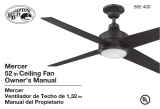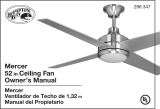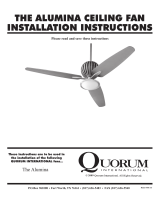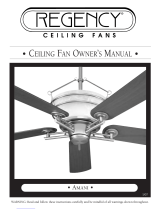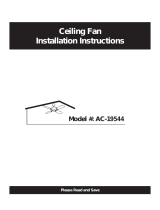Page is loading ...

GENERAL INSTALLATION & OPERATION INSTRUCTIONS
IMPORTANT SAFEGUARDS:
1. To ensure the success of the installation, be sure to read the instructions and review the diagrams thoroughly
To ensure the success of the installation, be sure to read the instructions and review the diagrams thoroughly
before beginning.
before beginning.
2. To avoid possible electric shock, be sure electricity is turned off at the main power box before wiring.
To avoid possible electric shock, be sure electricity is turned off at the main power box before wiring.
All
electrical connections must be made in accordance with local codes, ordinances and/or the National Electric
Code. If you are unfamiliar with the methods of installing electrical wiring and products, secure the services of a
qualified and licensed electrician as well as someone who can check the strength of the supportive ceiling
members and make the proper installation(s) and connections.
3. Make sure that your installation site will not allow rotating fan blades to come in contact with any object. Blades
should be at least 7 feet from floor.
4. When mounting on a ceiling outlet box, an approved box UL listed as "suitable for fan support"
"suitable for fan support"
is required. The
box and its supporting members must be able to support the moving weight of the fan's listed weight. The box
must not be able to twist or work loose. Installation on a concrete ceiling should be performed by qualified
personnel.
5. Blades should be attached after motor housing is hung and in place. Fan motor housing should be kept in the
carton until ready to be installed to protect its finish. If you are installing more than one ceiling fan, make sure
that you do not mix fan blade sets
do not mix fan blade sets
, as each blade is part of a weighted set.
6. After making electrical connections, spliced conductors should be turned upward and pushed carefully up into
outlet box. The wires should be spread apart with the common conductor and the grounding conductor on one
side of the outlet box, and the "HOT" wires on the other side.
7. Electrical diagrams are for reference only. Light kits that are not packed with the fan must be UL listed and
should be installed per the light kit's installation instructions.
8. After fan is completely installed, check to make sure that all connections are secure to prevent fan from falling
and/or causing damage or injury.
9. The fan can be made to work immediately after installation - the bearings are adequately charged with grease so
that, under normal conditions, further lubrication should not be necessary for the life of the fan.
10. To operate the reverse function on this fan, press the reverse button while the fan is running.
1
Weight of Fan: xxx lbs

IMPORTANT SAFETY PRECAUTIONS
• Disconnect power by removing fuse or turning off circuit breaker before installing the fan and/or optional lighting.
Disconnect power by removing fuse or turning off circuit breaker before installing the fan and/or optional lighting.
• Support directly from building structure.
• To reduce the risk of fire, electric shock, or personal injury, mount to outlet box marked "acceptable for fan
"acceptable for fan
support"
support"
and use mounting screws provided with the outlet box. Most outlet boxes commonly used for the support
of lighting fixtures are not acceptable for fan support and may need to be replaced. Consult a qualified electrician if
in doubt.
• Do not use an incandescent light dimmer. Do not use this fan with any transformer type fan speed control device.
• To reduce the risk of personal injury, do not bend the blade arms when installing them, balancing the blades or
cleaning the fan. Do not insert any object(s) between rotating fan blades.
NOTE:The important precautions, safeguards and instructions appearing in this manual are not meant to cover all
NOTE:The important precautions, safeguards and instructions appearing in this manual are not meant to cover all
possible conditions and situations that may occur. It must be understood that common sense, caution and carefulness
possible conditions and situations that may occur. It must be understood that common sense, caution and carefulness
are factors which cannot be built into this product. These factors must be supplied by the person(s) installing, caring
are factors which cannot be built into this product. These factors must be supplied by the person(s) installing, caring
for, and operating the unit.
for, and operating the unit.
2
Thank you for choosing a Regency Ceiling Fan. You have chosen the best!
Your new ceiling fan has been designed to provide many years of service and enjoyment.
Warnings:
Warnings:
TOOLS AND MATERIALS REQUIRED
• Phillips screwdriver
• Blade screwdriver
• Wrench or pliers
• Wire cutter
• Stepladder
• Wiring supplies as required by
electrical code

UNPACKING YOUR FAN
1. Unpack your fan and check the contents. Do not discard the carton. If warranty replacement or repair is ever
necessary, the fan should be returned in original packing. Remove all parts and hardware. Do not lay motor
housing on its side, or the decorative housing may shift, be bent or damaged.
2. Examine all parts. You should have the following:
1. Fan blades (5)
2. Mounting plate
3. Fan motor
4. Mounting plate
5. Light plate
6. Glass shade
7. 100W JD-type halogen bulb
8. Transmitter incl. holder + 2 mounting screws
9. Bracket mounting hardware (wood screws, screws, lock washers, washers, wire nuts)
10. Blade arm to blade screws, w/washers (16)
NOTE:
NOTE:
Design of parts shown above may look slightly different for your specific model of fan.
3
1
26
7
8
9
10
5
4
3

PREPARATION
PREPARATION:
Verify you have all parts before beginning the installation. Check foam insert closely for missing parts. Remove motor
from packing. To avoid damage to finish, assemble motor on soft padded surface or use the original foam inset in motor
box. Do not lay motor housing on its side as this could result in shifting of motor in decorative enclosure.
Do not lay motor housing on its side as this could result in shifting of motor in decorative enclosure.
Caution:
Caution:
To avoid possible electrical shock, be sure electricity
is turned off at the main power box before wiring. All wiring
must be in accordance with National and Local Electrical
Codes and the ceiling fan must be grounded as a precaution
against possible electric shock.
1. Locate ceiling joist where fan is to be mounted, being sure
location agrees with the requirements in the minimum
clearance section of this guide. Wood joist must be sound
and of adequate size to support 35 lbs. (See Page 1, Items 3
and 4).
2. If not already present, mount a UL listed outlet box marked
"suitable for fan support" following the instructions
provided with the outlet box. The outlet box must be able
to support a minimum of 35 pounds.
3. Attach mounting bracket to outlet box using screws
using screws
provided with the outlet box.
provided with the outlet box.
4
Parts identification on assembled fan
Blades
Mounting Plate
INSTALLING THE MOUNTING BRACKET
Motor Housing
Glass
Shade
Outlet box
Mounting
plate
Screws

INSTALLING THE FAN
5
INSTALLATION:
REMEMBER to turn off the power. Follow the steps below
to hang your fan properly.
Carefully lift fan motor assembly (without the blades) into
position by hanging the motor assembly onto the hook
from the ceiling mounting plate allowing it to hang freely
as shown in Fig. 5.
You are now ready to make the electrical connections.
ELECTRICAL CONNECTIONS
WARNING:
WARNING:
To avoid possible electrical shock, be sure
electricity is turned off at the main fuse box before wiring.
NOTE:
NOTE:
This remote control unit is equipped with 16 code
combinations to prevent possible interference from or to other
remote units. The frequency switches on your receiver and
transmitter have been preset at the factory. Please recheck to
make sure the switches on transmitter and receiver are set to
the same position, any combination of settings will operate
the fan as long as the transmitter and receiver are set to the
same position.
Note:
Note:
The receiver has been attached on the motor
housing and wired for ease of installation.
Follow the steps below to connect the fan to your household
wiring. Use the wire connecting nuts supplied with your
fan. Secure the connectors with electrical tape. Make sure
there are no loose strands or connections.
Outlet box
Fan
motor
Hook
Code switch
Receiver
(Pre-installed on top
of the motor housing)
Transmitter
ON
ON

FINISHING THE INSTALLATION
Step 1. Loosen two of the four screws from the mounting
plate and remove the other two.
Step 2. Remove the fan motor assembly from the mounting
plate hook and engage the key holes to the two screws
previously loosened.
Step 3. Install the two screws previously removed and
tighten all four screws.
6
Step 1 Connect the fan supply (black) wire to the black
household supply wire.
Step 2. Connect the neutral fan (white) wire to the white
neutral household wire.
Step 3 Connect the two green fan ground wires, located on
the mounting plate and motor, to the household ground
wire.
Step 4 After connecting the wires, spread them apart so that
the green and white wires are on one side of the outlet box
and the black wire is on the other side.
Step 5 Turn the connecting nuts upward and push the
wiring into the outlet box.
SUPPLY CIRCUIT
BLACK
WHITE
BLACK
GREEN
WHITE
Ground
Conductor
Outlet Box
Green
Ground
Lead
Ground to
Mounting
Plate
ELECTRICAL CONNECTIONS
Screws
Fan
motor
Mounting
plate

7
BLADE ATTACHMENT
INSTALLING THE MOUNTING PLATE
WARNING:
WARNING:
To reduce the risk of personal injury, do not
bend the blades while installing, balancing the blades, or
cleaning the fan.
Insert the blade through the slot in the housing. Align the
holes in the blade and the fan motor assembly and secure
with a blade attachment screw and fiber washer.
Repeat this procedure with the remaining blades.
1. Remove one of the three screws on the mounting hub
located on the fan motor.
2. Loosen the other two screws.
3. Install mounting plate to mounting hub.
4. Line up the two slotted holes with the two loose screws
on the mounting hub located on fan motor.
5. Re-install the third screw removed and tighten all three.
Fiber Washer
Screws
Blades
Screws
Mounting Hub
Mounting Plate

INSTALLING THE LIGHT BULB AND GLASS SHADE
WARNING:
WARNING:
Shut off the power supply before removing or
replacing lamp. In handling of halogen bulb, care should be
taken not to touch it with your bare hands. Oil residue will
shorten the life of the halogen bulb. If you accidentally
come into contact, wipe thoroughly with a clean, lint-free,
cotton cloth. Allow the bulb to cool for 10 minutes before
changing the bulb. Use light bulb in accordance with the
fan's specification. DO NOT EXCEED THE MAXIMUM
WATTAGE RATING.
Step 1. Remove the 1 of 3 screws from the posts of the light
kit decorative housing and keep it for future use. Loosen
the other 2 screws. (Do not remove)
Step 2. While holding the light kit assembly under your fan,
Make the polarized plug connections:
- White to white
- Blue to black
Step 3. Place the key holes on the light plate over the 2
screws previously loosened, turn the light plate until it
locks in place at the narrow section of the key holes. Secure
by tightening the 2 screws previously loosened and the one
previously removed. (Fig. 1)
Step 4. Install 1x100W halogen bulb (included) into bulb
socket. (Fig. 2)
Step 5. Raise glass shade up against mounting plate and secure
it to the fan by turning the glass shade clockwise until snug.
DO NOT OVERTIGHTEN.
Step 6. Restore power and your light kit is ready for operation.
8
Screws
Mounting Plate
Light Plate
Wire Connector
Bulb
Glass shade
Mounting Plate
Fig. 1
Fig. 2

9
OPERATING YOUR WALL TRANSMITTER
9 Volt
Battery
Restore power to ceiling fan and test for proper operation.
Install 9 Volt battery (not included). To prevent damage to transmitter remove
the batteries if not used for long periods of time. (Fig. 1)
1. "LO, MED, HI" buttons:
These three buttons are used to set the fan speed as follows:
LO= Low speed MED= Medium speed
HI= High speed
2. "FAN/OFF" button:
This button turns the fan off.
3. The " LIGHT" button are controlled by pressing the light button. Tap button
quickly to turn light off or on. Push the button once and release to turn the
light on to full brightness. Hold the button down to increase or decrease
light brightness. Release the button at the desired light brightness and that
setting will be remembered the next time the light is turned on. The pre-set
brightness can be changed by holding down the light button again until the
new desired brightness is reached.
NOTE:
NOTE:
If power is lost to the fan receiver, the memory will be lost and all
settings will return to the default.
4. "FOR/REV" button:
This button is used to change the direction of the rotation of the blades;
forward for warm weather or reverse for warm weather.
Fig. 1
Fig. 2

10
INSTALLING THE TRANSMITTER HOLDER
1. Attach the holder with the two screws provided.
Holder
Screws
Fig. 3 Fig. 4
Speed settings for warm or cool weather depend on factors such as the room size, ceiling height, number of fans, etc.
NOTE:
NOTE:
To operate the reverse function on this fan, press the "FOR/REV" button while the fan is running.
Warm weather-(Counter-Clockwise direction) A downward air flow creates a cooling effect.(Fig. 3) This allows you
to set your air conditioner on a higher setting without affecting your comfort.
Cool weather-(Clockwise direction) An upward airflow moves warm air off the ceiling area.(Fig. 4) This allows you
to set your heating unit on a lower setting without affecting your comfort.
NOTE:
NOTE:
Range of the transmitter is approximately 25 ft. A new alkaline battery will typically give range of 35 ft. or more.

CARE AND CLEANING
Periodically it may be necessary to re-tighten blade to blade arm screws or blade arm to motor screws to prevent clicking
or humming sound during operation. This is especially true in climates with broad temperature and humidity ranges.
When dusting the blades, you must support the blade to prevent bending - no pressure should be applied to the blades.
If you experience any flaws in the operation of your fan, please check the following points.
TROUBLESHOOTING - IN CASE OF DIFFICULTY
CAUTION:
CAUTION:
Switch off power supply before carrying out any of these checks.
1. If fan will not start: Check main and branch circuit breakers and/or fuses. Check line wire connections to fan housing
wiring. Check to make sure the dip switches from the transmitter and receiver areset to the same frequency.
2. If fan is noisy: Check and make sure that all screws in motor housing are snug (but not over tight). Check that the
screws securing blade arms to the motor are tight. Check that wire connectors in switch housing are not rattling
against each other or the interior wall of the switch housing. Check that all glassware is finger tight and that bulb(s)
are well held in the sockets, if a light kit is used. Check that the canopy is firmly attached to hanging bracket and not
vibrating against ceiling.
3. If fan wobbles: Check that all blades are firmly screwed into blade arms. Check that all blade arms are firmly secure to
the motor. Check to make sure that light kit (if present) is firmly attached to switch housing and that all glassware
and shades are fastened properly. Wobble can also result from even the smallest deviations in distance from blade tip
to blade tip. If measurements from blade tip to blade tip are not equal, loosen screws connecting blade to blade arm
one at a time and adjust blade(s) so that distances are equal. Interchanging adjacent blades may redistribute mass and
result in smoother operation. Blade arms can be bent slightly to restore same pitch to all blades if a blade is different
than the other blades when viewed edge on. Most wobble can be traced to a loose electrical box or mounting bracket.
Make sure these are tight and the ball is completely seated in the bracket.
11
THANK YOU FOR PURCHASING A REGENCY CEILING FAN.
Write to us at:
Regency Ceiling Fans
P.O. Box 730
Fenton, MO 63026
Visit us on the Web at: www.regencyfan.com
01/13 Regency Ceiling Fans
/


